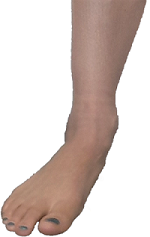
Anterior Tibialis Muscle Pain

What is Anterior Tibialis Muscle Pain?
The anterior tibialis muscle pain comes from the muscle, which lies at the front of the lower leg, and attaches to the top of the foot. Pain in this area can be confused with shin splints, which is pain on the inside of the lower leg/shin. Instead, this pain would be at the front of the lower leg to the outside of the tibia bone, or at the tendon on the top of the foot. This tendon is the large tendon visible crossing the front of the ankle. One of the main functions of the anterior tibialis muscle is to pull the foot up (ankle flexion or dorsiflexion), and it assists in keeping the arch from collapsing.
When the anterior tibialis muscle is overworked or injured, pain can develop here.
Causes of Anterior Tibialis Muscle Pain

Mechanics
Because the anterior tibialis muscle assists in keeping the medial (inside) arch up, an arch collapse can overwork the muscle.
If there is pain elsewhere causing an abnormal gait, the anterior tibialis muscle may compensate by overworking. One example of this is pain at the ball of the foot causing a heel walk, which activates the anterior tibialis muscle with more force and for a longer period of time.
Another instance when the tibialis anterior muscle becomes overworked, is when another related muscle is weak or not activating properly. If the tibialis anterior muscle has to take over the job of another muscle, the load may be too much to handle.
Injury
It is very rare to tear or injure the anterior tibialis muscle from a sudden injury. If this does occur, your family doctor or a physiotherapist would be more specialized to deal with this particular injury. The pedorthic treatments listed below may help to assist in the recovery process, but as a secondary treatment.
What will I feel and see?
When the anterior tibialis muscle is overworked, you may experience pain or tightness at the front of the lower leg. This can be while walking or while applying pressure to the affected area. While walking, the pain would be more severe while lowering your foot to the ground, immediately after heel strike.
If this pain originates from foot mechanics, the foot mechanics causing the pain may be visibly seen. Look for an arch collapse or the heel rolling in. You may also notice the ankle rolling inwards, or the foot turning out slightly.
Pedorthic Treatments/Prevention
Orthotics
Orthotics help to support the foot and reduce strain to the anterior tibialis muscle. If this strain occurs due to a collapsed arch, the orthotic device helps to push the foot and release strain at the anterior tibialis muscle. It can also occur due to a compensation from pain. To prevent this compensation, the pain must first be dealt with. If the pain is due to a collapse of the arch or other mechanics in the foot, the orthotic device supports the foot to prevent the need for excessive compensation.
In the case of a sudden injury, the mechanics of the foot may not have caused the injury, but may play a factor in the recovery. If the anterior muscle already works harder than normal, this can hinder the recovery process.
Footwear
Using the right footwear can be beneficial to reduce strain to the anterior tibialis muscle by assisting with the proper support. The proper footwear helps to compliment an orthotic device. An improper shoe can mean an orthotic may not be working to it’s full potential. The proper shoe can depend on the specific foot mechanics. In most cases, a neutral running shoe or walking shoe is appropriate to wear with an orthotic device. In some cases, with the advice from your orthotic professional, a stability running shoe may be necessary in combination with the orthotic device.
Another factor to consider with the anterior tibialis muscle is the weight of the shoe. If the tibialis anterior muscle is weak or healing is slow, a lighter shoe may be recommended. If a physiotherapist is rehabilitating the muscle, they may provide recommendations on the shoe weight.
Other
Other treatments, such as physiotherapy, may be recommended to address the tibialis anterior muscle pain. This treatment may be beneficial to improve the healing, or to address any muscle issues. If there are muscle imbalances, rehabilitation is typically recommended to address the imbalance.
If it sounds like a condition you have, or you would like more information, feel free to contact us or book an appointment!

You must be logged in to post a comment.